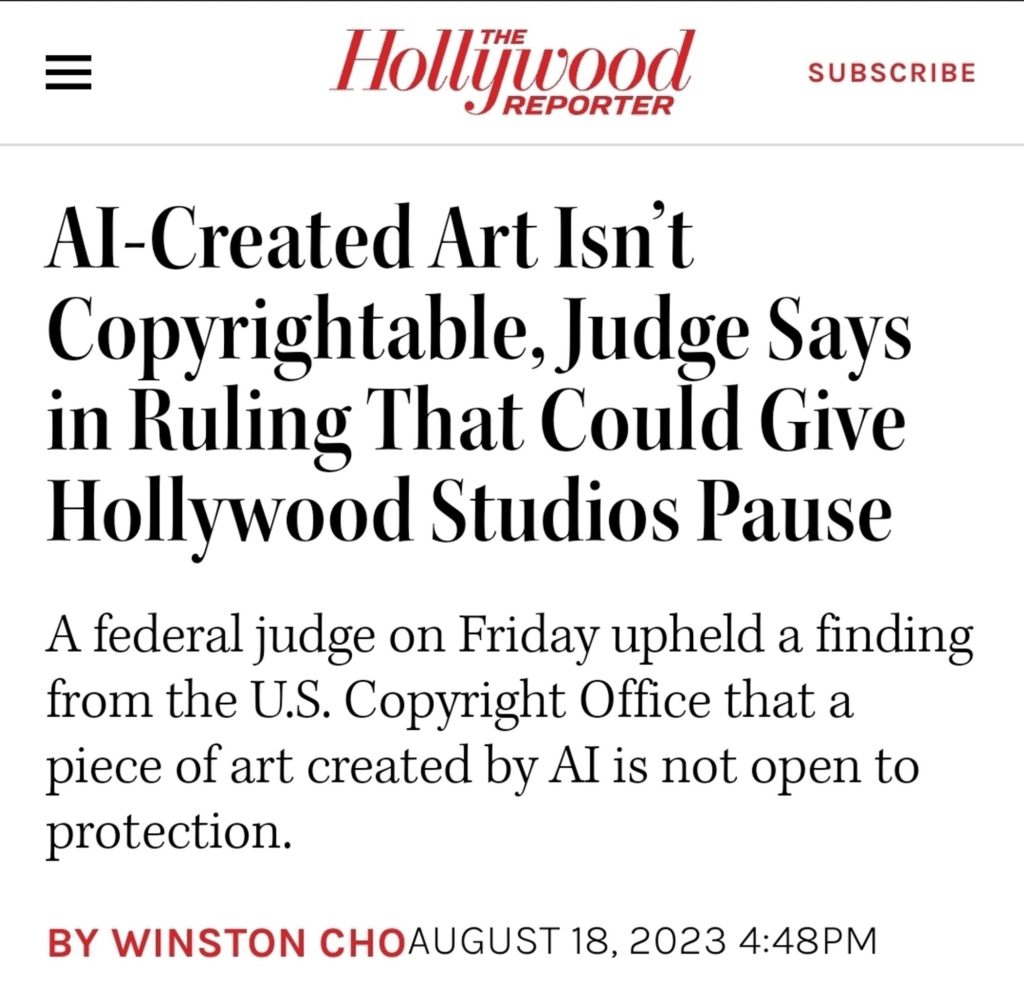Hollywood: The potential reduction in the value of labor is limitless, while the scope for expanding copyright is boundless.
Tech: Omg, secret invasion disney+ intro is public domain!
Hollywood: 😀😐😬🫣😦☹️😱 the datasets are based on copywritten stuff we own
Tech: 🤷A dataset just fell off a truck

https://warpcast.com/bravojohnson/0x92019b
<>
Tech: “Rich Men North of Richmond”🎶🎼🎵we’ve never been so poor
Hollywood: we lost money on Hillbilly Elegy
Tech: “Fat people on welfare🎶🎵🎼tax dollars on your fudge”
Hollywood: High-tech haystacks
Tech: “Lower taxes more Jesus🎵🎼🎶 Binary Bales and Barnyards”
Hollywood:😬
Tech: Tech tracks and tractor paths. 🎶🎼🎵We’re so back y’all
<>
Music Industry: More followers than Tyler Childers? Ain’t no way.
Tech: Rich man North of Richmond 🎵🎼🎶 Fat people on welfare🎶🎵🎼tax dollars on your fudge” Sign up for Blue and within days you too can have a country follow
Music Industry: Industry plant
Tech: Lower taxes and more Jesus🎵🎼🎶 Hey Jason Isbell. Why won’t you debate @aintgottadollar? 🎼🎵🎶 I have Dogwhistles on a trench coat 🎶🎵🎼you wear pronouns on your sleeve
Music Industry: 🫤
<>
Hollywood: This fall we’re planing our mayor thumbnail overhaul
Tech: 😶
Hollywood: We want you to feel sorry for not giving Airwolf, Inside the real narcos or Hannibal tv series a fair shot
Tech: 😬
Hollywood: Also we’re trying our new Chinese Room AI enhanced customer support
<>
Tech: Burn cash, grow user base, never profit
Hollywood: What?
Tech: Burn cash, grow user base, never profit
Hollywood: We can’t do that anymore. We need something like quantum accounting
Tech: Burn cash, grow user base, never profit
Hollywood: Are you ok?
Tech: Burn cash, grow user base, never profit
<>
Music Industry: I’m the ghost of business cycles past 👻⛓️💀🪦Technology doesn’t drive disruption~~business models do
Hollywood: Is that you Jacob? you wearing so many chains?
Music Industry: Each chain a missed opportunity. Technology as enabler, changing customer expectations, fragmentation of revenue
Tech: Is he alright?
Hollywood: They haven’t sign a new act in 25 years but Licencing is a bunch. Just zombie
Tech: Thankfully we will always be immune to changes in consumer behavior
Music Industry: 👀
Hollywood/ 👀
Tech: I feel partially responsible 😕
Hollywood: Don’t worry. He would have done the same. Remember the MiniDisc, the DCC, 8-Track Tape, DAT, Cylinder Records etc
Tech 😡Never again. They will eat their veggies, ask for seconds and say thank you
Hollywood: It’s all good now
Tech: look what they did to my boys
Hollywood: Attaboy. Now let see if we can put one on the actors
Tech: You can’t tell me what to do. I’m all grown up, now
Hollywood: 🧤🧤
<>
Tech: the thing about streaming is that you’re all making a lot more money than anybody knows and that you’re willing to tell us.
Hollywood: Yes
Tech: Or you’re making a lot less money than anybody knows. And you don’t want Wall Street to look under the hood of this thing in any significant way because there’ll be a reckoning that will be quite unpleasant.
Hollywood: Yes
Hollywood: Wow, IPhone 18
Tech: What can I say. Barbie 5 and Oppenheimer IV: Son of Oppenheimer
THE SCRIPT
Tech: So I’m a bit of a semiconductor specialist, myself
Hollywood: I’m a Nuclear scientist AMA
Tech: sometimes the rapid pace of advancement can lead to the delusion that technology can solve every problem effortlessly.
Hollywood: Nuclear science too. Benefits galore, but the same delusion haunts us.
Tech: And then everyone takes credit for your work
Hollywood: Yes, its
impostors all the way down
Tech: I’ve got a script about a self-made VC facing off against lack of scalability, weak mgt, slow traction, limited advantage, and unclear exit strategy. 🎬
Hollywood: Seems original….but we can fix that
Tech: people in the arena vibe
AI
Tech: Saw that 900k AI gig
Hollywood: Expelliarmus
Tech: Protego totalum
Hollywood: We just wanna cast a spell and write out writers and act out actors
Tech: we don’t have writers.
Hollywood: The code writes itself?
Tech: Open source. I think you’d call it spec
Hollywood: Neat Tech: Main character superpower
BARBENHEIMER
Tech: Why so glum? I really enjoyed Barbenheimer
Hollywood: meh Tech: ?
Hollywood: I mean it’s the opposite of everything we have been doing for the last 20 years
Tech: People want a common story. It was fun
Hollywood: Well, We’re selling vertical integration, theater choices and everyone eagerly agreeing,
Tech: 😬
Hollywood: We could use some new idea to win this thing.
Tech: Well, capital factory line is shutdown, inventory is over marked. Need to work through some things, wash out others and let the rest expire
Hollywood: Tldr. Unicorns?
Tech: Can’t get public. Back to high risk capital and no packaging
Holywood: 😬
OPPENHEIMER
Tech: So, Oppenheimer was a leftist?
Hollywood: Yep
Tech: Well, Nolan lead us to believe Oppie was small government libertarian entrepreneur simpatico with inception bros
Hollywood: it’s complicated
Tech: I think Nolan missed the whole Elon, Thiel connection.
Hollywood: There are many layers. Have you tried the IMAX?
Tech: what about the whole contrarian venture capital?
Hollywood: 🫤
Tech: 🚩
AD REVENUE
Tech platforms: You guys should bundle up
Hollywood: You mean cable?
Tech platforms: Erm 🫤 it’s wireless
Hollywood: Ok
Tech platforms: This week only we’re offering 50% rate discount on ad space
Hollywood: Talk to you in 6 months
Hollywood: Raincheck?
ADS
Tech Platforms: We’ve been lying to you about conversion rates
Hollywood: Yeah, we kind of knew it but was a useful lie during ZIRP. Outstanding club to hit people with
Hollywood: Can you cover for declining box office and streaming numbers?
Tech Platforms: Eyeballs are overrated
Hollywood: We also had a couple of zirp accounting tricks if we’re gonna be honest
Tech Platforms: I hear you. Truth can be so dull. We’re offering Media buyout meta discounts. Very competitive
Hollywood: Reality bites ass
STRIKE
Last time around execs had ZIRP protection. Aamof superheroes superpower was always massaging numbers up or down the calendar